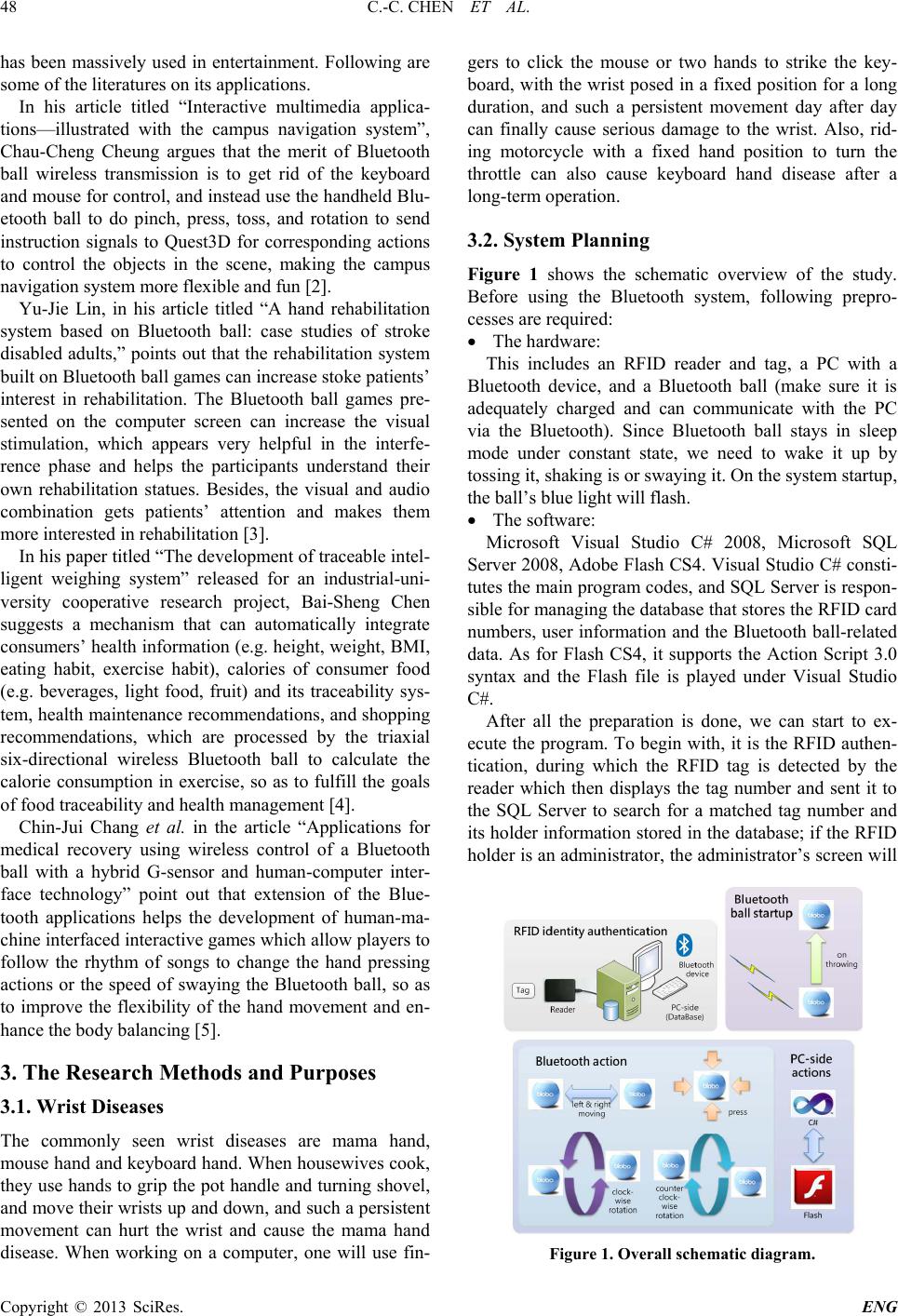
C.-C. CHEN ET AL.
Copyright © 2013 SciRes. ENG
has been massively used in entertainment. Following are
some of the literatures on its applications.
In his article titled “Interactive multimedia applica-
tions—illustrated with the campus navigation system”,
Chau-Cheng Cheung argues that the merit of Bluetooth
ball wireless transmission is to get rid of the keyboard
and mouse for control, and instead use the handh eld Blu-
etooth ball to do pinch, press, toss, and rotation to send
instruction signals to Quest3D for corresponding actions
to control the objects in the scene, making the campus
navigation system more flexible and fun [2].
Yu-Jie Lin, in his article titled “A hand rehabilitation
system based on Bluetooth ball: case studies of stroke
disabled adults,” points out that the rehabilitation system
built on Bluetooth ball games can increase stoke patients’
interest in rehabilitation. The Bluetooth ball games pre-
sented on the computer screen can increase the visual
stimulation, which appears very helpful in the interfe-
rence phase and helps the participants understand their
own rehabilitation statues. Besides, the visual and audio
combination gets patients’ attention and makes them
more interested in rehabilitation [3].
In his paper titled “The development of traceable intel-
ligent weighing system” released for an industrial-uni-
versity cooperative research project, Bai-Sheng Chen
suggests a mechanism that can automatically integrate
consumers’ health information (e.g. height, weight, B MI ,
eating habit, exercise habit), calories of consumer food
(e.g. beverages, light food, fruit) and its traceability sys-
tem, health maintenance recommendations, and shopping
recommendations, which are processed by the triaxial
six-directional wireless Bluetooth ball to calculate the
calorie consumption in exercise, so as to fulfill the goals
of food traceability and health management [4].
Chin-Jui Chang et al. in the article “Applications for
medical recovery using wireless control of a Bluetooth
ball with a hybrid G-sensor and human-computer inter-
face technology” point out that extension of the Blue-
tooth applications helps the development of human-ma-
chine interfaced interactive games which allow players to
follow the rhythm of songs to change the hand pressing
actions or the speed of swaying the Bluetooth ball, so as
to improve the flexibility of the hand movement and en-
hance the body balancing [5].
3. The Research Methods and Purposes
3.1. Wrist Diseases
The commonly seen wrist diseases are mama hand,
mouse hand and keyboard hand. When housewives cook,
they use hands to grip the pot handle and turning shovel,
and move their wrists up and down, and such a persistent
movement can hurt the wrist and cause the mama hand
disease. When working on a computer, one will use fin-
gers to click the mouse or two hands to strike the key-
board, with the wrist posed in a fixed position for a long
duration, and such a persistent movement day after day
can finally cause serious damage to the wrist. Also, rid-
ing motorcycle with a fixed hand position to turn the
throttle can also cause keyboard hand disease after a
long-term operation.
3.2. System Planning
Figure 1 shows the schematic overview of the study.
Before using the Bluetooth system, following prepro-
cesses are required:
• The hardware:
This includes an RFID reader and tag, a PC with a
Bluetooth device, and a Bluetooth ball (make sure it is
adequately charged and can communicate with the PC
via the Bluetooth). Since Bluetooth ball stays in sleep
mode under constant state, we need to wake it up by
tossing it, shaking is or swa ying it. On the syste m startup,
the ball’s blue light will flash.
• The software:
Microsoft Visual Studio C# 2008, Microsoft SQL
Server 200 8, A dobe Flash CS4. Vis ual Studio C# consti-
tutes the main program codes, and SQL Server is respon -
sible for managing the database that stores the RFID card
numbers, user information and the Bluetooth ball-related
data. As for Flash CS4, it supports the Action Script 3.0
syntax and the Flash file is played under Visual Studio
C#.
After all the preparation is done, we can start to ex-
ecute the program. To begin with, it is the RFID authen-
tication, during which the RFID tag is detected by the
reader which then displays the tag number and sent it to
the SQL Server to search for a matched tag number and
its holder information stor ed in the database; if the RFID
holder is an administrator , the administrator’s screen w ill
Figure 1. Overall schematic diagram.